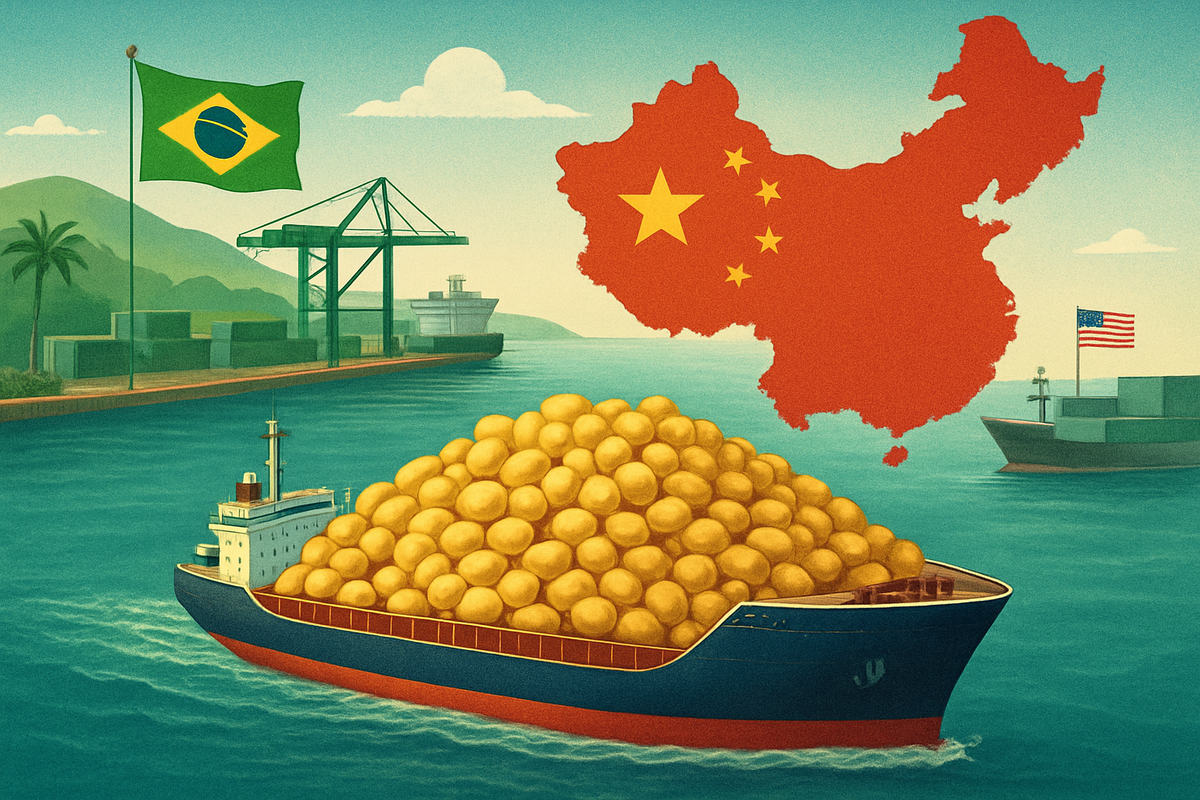
As of November 14, 2025, China continues to solidify its strategic preference for Brazilian soybeans, a move that is dramatically reshaping global agricultural commodity markets. Despite a recently announced trade deal with the United States, Beijing's purchasing patterns overwhelmingly favor South American supplies, reinforcing Brazil's position as the dominant global exporter and leaving the U.S. soybean market grappling with uncertainty and depressed demand. This dual-sourcing strategy underscores China's unwavering commitment to food security and supply chain diversification, with profound immediate implications for prices, trade flows, and the economic well-being of farmers worldwide.
Detailed Coverage: China's Unwavering Embrace of Brazilian Soybeans
China's pivot towards Brazilian soybeans is not a fleeting market anomaly but a deeply entrenched strategy, evident throughout 2024 and 2025. This persistent shift has been driven by a complex interplay of economic incentives, strategic imperatives, and lingering geopolitical tensions, leading to significant reactions across global agricultural markets.
The "recent US deal" primarily refers to an agreement announced on October 30, 2025, where the U.S. stated China had committed to purchasing 12 million metric tons of U.S. soybeans by the end of 2025, with an additional 25 million metric tons annually from 2026 to 2028. This deal also reportedly included a reduction of tariffs on U.S. agricultural products. However, Beijing has not officially confirmed these specific commitments, and market actions suggest a continued preference for Brazilian supplies. For instance, the Chinese state-owned agricultural firm COFCO Corporation (HKEX: 00606) recently signed agreements to buy over $10 billion worth of Brazilian agricultural products, including soybeans, without explicit mention of U.S. purchases.
Throughout 2025, China has demonstrated a strong preference for Brazilian soybeans. Brazil achieved record-setting shipments to China from January through August 2025, with exports reaching a historic $6.6 billion in the first quarter alone. By July 2025, China accounted for 78% of Brazil's total soybean exports. This preference is largely driven by a significant price advantage, as Brazilian soybeans are approximately $60-$70 per ton cheaper than U.S. supplies due to a lingering 13% retaliatory tariff on American beans. Conversely, U.S. soybean exports to China have seen a dramatic decline in 2025, totaling merely 218 million bushels from January to August, a sharp drop from 985 million bushels in 2024, with virtually non-existent shipments in June, July, and August.
Key players in this evolving dynamic include the Chinese government, which prioritizes food security and supply chain diversification; Chinese importers and crushers like COFCO Corporation (HKEX: 00606) and Sinograin (private), who make purchasing decisions based on price and reliability; Brazilian farmers and exporters, who are direct beneficiaries of increased Chinese demand; and the U.S. government and American Soybean Association (ASA), representing U.S. farmers who are advocating for more favorable trade conditions. Initial market reactions reflect significant stress among U.S. soybean farmers facing falling prices and lost export sales, while the Brazilian soybean industry is experiencing a boom, anticipating new record exports. Global soybean prices are experiencing volatility, with U.S. futures negatively impacted and Brazilian prices climbing due to intensified competition.
Market Movers: Winners and Losers in the Soybean Saga
China's unwavering commitment to Brazilian soybeans, even in the face of U.S. trade overtures, creates a clear delineation of winners and losers within the global agricultural supply chain. This strategic divergence is not merely shifting trade routes but fundamentally altering the fortunes of key industry players.
On the winning side are undoubtedly Brazilian soybean producers and exporters. Major Brazilian agribusiness firms such as Amaggi (private), SLC Agrícola (B3: SLCE3), and Grupo Bom Futuro (private) are direct beneficiaries. Brazil is projected to produce a staggering 169 million metric tons of soybeans in the 2024/25 season, with China absorbing approximately 75% of its exports. This robust demand translates into higher export volumes, stable prices, and increased revenues for these companies. COFCO International (private), while a Chinese state-owned entity, has significant operations and investments in Brazil, effectively leveraging its Brazilian supply chain to meet China's demand.
Global agricultural trading houses with strong Brazilian infrastructure, often referred to as the "ABCDs" – Archer Daniels Midland (ADM) (NYSE: ADM), Bunge Global SA (BG) (NYSE: BG), Cargill (private), and Louis Dreyfus Company (private) – are also strategically positioned to win. While their U.S. operations might face headwinds, their extensive presence in Brazil allows them to pivot sourcing strategies to fulfill Chinese demand for cheaper Brazilian beans. Their integrated logistics and processing capabilities enable them to capitalize on price differentials and diversified supply chains, as evidenced by COFCO's recent agreements to purchase large volumes of Brazilian agricultural products from these firms. Chinese state-owned importers and processors like COFCO Corporation (HKEX: 00606) and Sinograin (private) also benefit from securing a cheaper and more reliable source in Brazil, aiding in meeting China's massive domestic demand for soybean meal and oil.
Conversely, U.S. soybean farmers are among the most significant losers. Despite the recent trade deal, China's continued preference for Brazilian soybeans translates to reduced export opportunities, weaker demand, and downward pressure on prices for U.S. beans. The persistent 13% tariff on U.S. soybeans keeps them at a price disadvantage, leading to lower revenues for farmers and potential oversupply in the domestic market. This situation could influence planting decisions for the 2026 season, with some farmers considering a shift away from soybeans.
U.S.-centric soybean exporters and processors, particularly smaller grain elevators, cooperatives like AGP (private), CHS Inc. (private), and Landus Cooperative (private), and regional processors, face reduced export volumes and narrower margins. These companies, often lacking diversified global sourcing or robust South American infrastructure, struggle to compete with the cheaper Brazilian supply reaching China. Even the major ABCD firms, while adaptable, might see underutilization of their U.S.-based origination, storage, and transportation assets that were built to serve the Chinese market, leading to more challenging operating conditions for their U.S. trading desks.
Wider Significance: A New Era for Global Agricultural Trade
China's enduring preference for Brazilian soybeans, even amidst diplomatic overtures and trade agreements with the U.S., signifies a profound and likely permanent realignment in global agricultural trade. This shift is deeply rooted in China's strategic pursuit of food security, economic diversification, and geopolitical considerations, marking a departure from previous trade dynamics.
This event fits into a broader industry trend of supply chain diversification and de-risking. China, having experienced the vulnerabilities of relying heavily on a single supplier during the 2018 trade war, is systematically building more resilient and politically insulated supply chains. Soybeans, critical for its vast livestock industry, are at the forefront of this strategy. This has solidified Brazil's ascendance as a global agricultural powerhouse, with significant investments in production capacity and export infrastructure, further cementing its role as the world's largest soybean producer and exporter.
The ripple effects are substantial. For U.S. farmers, the reduced market share in China has inflicted severe economic hardships, leading to lower prices and significant financial losses. U.S. agricultural exports to China are projected to drop substantially in 2025 and 2026, exposing deep vulnerabilities in the rural American economy. Conversely, Brazilian farmers are directly benefiting from China's robust demand, leading to increased production and strong export growth. Argentina, another major South American soybean producer, has also capitalized on the US-China trade tensions, boosting its soybean sales to China.
Regulatory and policy implications are also significant. The persistent tariffs and trade tensions between the U.S. and China remain a primary factor, with the cumulative duty rate on U.S. soybeans effectively rendering them uncompetitive. China's policy extends beyond mere price arbitrage to a strategic imperative to enhance food security, including potential domestic measures to reduce soybean meal in animal feed. Furthermore, the surge in Brazilian soybean production, driven by Chinese demand, raises environmental concerns, particularly regarding deforestation in critical biomes like the Amazon and Cerrado, which could lead to increased scrutiny and potential trade barriers from other environmentally conscious markets.
Historically, this situation echoes the 2018 U.S.-China trade war, which first prompted China's pivot to Brazil. However, the current situation in 2025 suggests a deeper, more permanent entrenchment of this diversification strategy. A more distant but relevant precedent is the 1973 U.S. soybean embargo, which similarly prompted countries like Japan to question the reliability of the U.S. as a sole supplier and implement policies to enhance their food security. China's current actions reflect a similar strategic response, aiming to insulate its critical food supply from geopolitical fluctuations and ensuring a lasting transformation of global soybean trade.
What Comes Next: Navigating the Evolving Soybean Landscape
The current trajectory of China's soybean sourcing points to a "new normal" where Brazil maintains its strong lead as China's primary supplier, while U.S. exports remain subdued, often influenced more by diplomatic gestures than pure market demand. This structural shift is expected to deepen, with both short-term and long-term implications for the global agricultural sector.
In the short term (next 6-12 months), skepticism regarding the full fulfillment of the recently reported U.S.-China soybean deal is high, given prevailing prices and tariffs. Brazil is poised for another record harvest in 2025/2026, projected at 177.6 to 178 million tons, ensuring continued dominance in meeting China's demand. U.S. soybean farmers will likely face persistent oversupply and depressed prices, potentially leading to further shifts in planting decisions towards other crops like corn. Market volatility will remain elevated due to geopolitical tensions and policy uncertainties, while Europe might see an influx of cheaper U.S. soybeans, benefiting consumers but potentially challenging its domestic sector.
Longer term (1-5+ years), the deepening agricultural ties between China and Brazil, fueled by continued investments in logistics and infrastructure, will likely solidify Brazil's role as China's leading soybean provider. This signifies a permanent shift in global trade patterns, with agricultural trade becoming more fragmented and influenced by geopolitics. China's domestic efforts to boost soybean production and reduce soybean meal content in animal feed could gradually decrease its overall import volumes, though it will remain the world's largest importer. The U.S. will be compelled to aggressively explore and develop new export markets in regions like India, Africa, and parts of Europe to offset diminished Chinese demand, while all major producers will need to invest in technological advancements and sustainable practices to ensure supply stability.
Potential strategic pivots are crucial. China will continue to deepen its ties with Brazil and other Latin American suppliers, enhance domestic production, and utilize strategic reserves. The U.S. must aggressively diversify its export markets, address price competitiveness through policy, and support farmers in adapting planting strategies. Brazil, while capitalizing on its dominance, should manage over-reliance on Chinese demand, strengthen sustainability practices, and continue infrastructure development. Market opportunities include enhanced leadership for Brazil, improved food security for China, and new trade relationships for the U.S. Challenges include persistent low prices for U.S. farmers, environmental scrutiny for Brazil, and increased politicization of global trade.
Wrap-Up: A Lasting Transformation in Global Agribusiness
China's unwavering commitment to Brazilian soybeans, despite ongoing diplomatic efforts and trade agreements with the United States, marks a lasting transformation in global agribusiness. This strategic pivot, initiated during the 2018 trade war, has firmly entrenched Brazil as the world's leading soybean exporter and redefined the competitive landscape for agricultural commodities.
The key takeaway is that geopolitical considerations and a strategic pursuit of food security have superseded purely economic factors in shaping China's purchasing decisions. Brazil's consistent supply, competitive pricing, and China's substantial investments in its agricultural infrastructure have created a formidable and resilient supply chain. For the U.S., this signifies a permanent loss of a significant portion of its largest soybean market, necessitating a fundamental re-evaluation of its agricultural export strategy and a greater emphasis on domestic demand, such as the growing renewable diesel sector, which is increasing US soybean crush capacity.
Moving forward, the market will continue to reflect this "new normal." Brazil is projected to maintain its dominance, with record harvests and exports expected for the 2025/2026 season. China's overall soybean demand, while robust, will be increasingly met by Brazilian supplies, further compounded by China's own efforts to boost domestic production and reduce reliance on soybean meal in animal feed. The persistent 13% tariff on U.S. soybeans will continue to render them commercially uncompetitive in China, underscoring the deep-seated nature of this trade realignment.
Investors in the agricultural sector, particularly those focused on soybeans, should closely monitor several factors in the coming months:
- US-China Trade Relations and Tariff Status: While a deal has been announced, its full implementation and long-term stability remain uncertain. Any further escalation or de-escalation of trade tensions, particularly regarding tariffs on agricultural products, could significantly impact trade flows and prices.
- South American Crop Development: Brazil is expected to have a record harvest, but weather patterns (like soil moisture deficits in central and northern Brazil) for the upcoming Brazilian and Argentinian crops (planting for 2025/2026 season is underway) will be crucial. A poor harvest in South America could force China to increase US purchases or draw down reserves, impacting global prices.
- Chinese Demand and Economic Health: China's continued strong demand for soybeans, driven by its large animal protein industry, is a primary market driver. Any changes in China's domestic economic growth, hog herd recovery, or policy shifts regarding feed formulas could affect import volumes.
- Price Spreads between US and Brazilian Soybeans: The relative price competitiveness between US and Brazilian soybeans will continue to dictate Chinese buying patterns. Investors should watch for changes in freight rates, currency exchange rates (e.g., Brazilian Real devaluation), and export taxes that could alter these price dynamics.
- US Domestic Soybean Use and Biofuel Policies: The growth of US domestic soybean crush capacity, particularly for renewable diesel production, provides an alternative demand channel for US soybeans. Changes in US biofuel policies could influence domestic crush volumes and, consequently, exportable supplies.
- USDA Reports (WASDE): The monthly World Agricultural Supply and Demand Estimates (WASDE) reports from the USDA will provide critical updates on crop forecasts, export projections, and ending stocks for both the US and South America. The November 14th WASDE report is particularly important given its timing and prior government shutdowns.
The soybean market will remain a complex interplay of agricultural fundamentals, geopolitical maneuvering, and evolving global trade strategies.
This content is intended for informational purposes only and is not financial advice







